
The history of rail transport in Portugal dates from 28 October 1856, when Portugal's first railway line was opened between Lisbon and Carregado: the Companhia dos Caminhos de Ferro Portugueses.

The Série 1800 were a series of 10 diesel-electric locomotives built for the Portuguese Railways (CP) in 1968. Designed and engineered by English Electric, they were closely modelled on the British Rail Class 50 locomotives but built for CP's 1,668 mmIberian gauge and larger loading gauge than possible in Great Britain.

The Série 1400 are a series of 67 diesel-electric locomotives built for the Portuguese Railways (CP) between 1967 and 1969. They have a top speed of 105 km/h.

The Série 1900 locomotives of Portuguese Railways are 13 diesel-electric locomotives built in 1981 for freight duties. Prior to electrification, coal trains were hauled by triple-headed Série 1900 locomotives inland from the Port of Sines. The locomotives were built by Sorefame under licence from the French company Alsthom and are visually similar to SNCF Class CC 72000. They have a top speed of 100 km/h (62 mph).
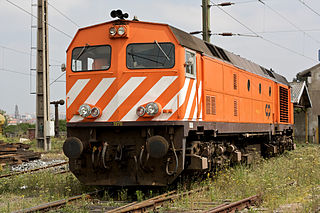
Série 1960 are a class of diesel-electric locomotives built for Portuguese Railways (CP). They were constructed by Bombardier Transportation and entered service in 1979. Of the 13 built, 5 remain in service in 2012. They have a top speed of 120 km/h and weigh 121 tonnes.
Série 2500 were the first 15 electric locomotives built for the Portuguese Railways (CP). They entered service in 1956, for the newly electrified 25 kV line running north from Lisbon. They had a maximum speed of 120 km/h. They were withdrawn from service in 2009; all but one have been sold for scrap.
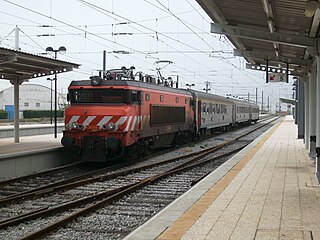
Série 2600, nicknamed Nez-Cassée("broken nose"), is a type of 25 kV 50 Hz electric locomotive formerly used by Portuguese Railways. They are closely based on the SNCF Class BB 15000 locomotive design. The locomotives were styled by Paul Arzens, designed by Groupement 50Hz and entered service in 1974. Of the 12 built, 9 were still in service in 2012. They have a top speed of 160 km/h.
Série 1150 are small Sentinel shunting locomotives built in 1966-1967 for Portuguese Railways (CP). They are based on the "Steelman" shunting locomotive used at various industrial plants arounds the UK. They have a maximum speed of 58 km/h. As of 2012, seven locomotives remain in service.
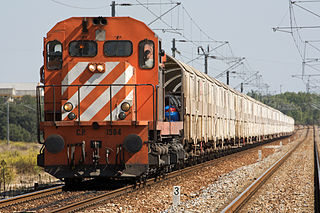
The Série 1550 are a series of 19 diesel-electric locomotives built for the Portuguese Railways (CP). They entered service in 1973; they were built in Canada by the Montreal Locomotive Works (MLW). The locomotives are MLW's type MX 620 design.
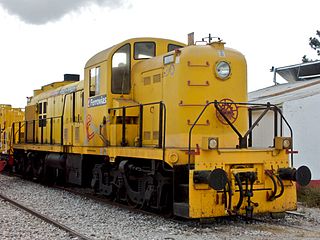
The Série 1500 of the Portuguese Railways were introduced in 1948, making them amongst the first main line diesel locomotives to be used in Europe. These 12 locomotives were built in the United States by ALCO, to the constructor's type RSC-2 specification. The locomotives were purchased with assistance from Marshall Aid funds in an attempt to cut the railway's running costs, modernise the system and help alleviate Portugal's shortage of coal following World War II.
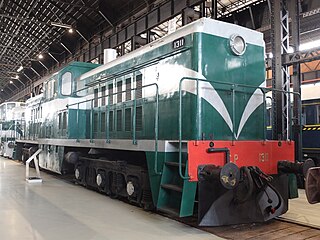
The Série 1300 were a class of diesel locomotives used by Portuguese Railways (CP). They entered service in 1952; all are now withdrawn from service.

The Série 1320 were a class of diesel locomotives used by Portuguese Railways (CP). All have now been withdrawn from service.

The RENFE 313 was a class of 6 axle mainline diesel-electric locomotives built for RENFE by Euskalduna under license from Alco. 50 units were built in the mid-1960s, locomotives surplus to RENFE's requirements were sold to Comboios de Portugal (CP), Trenes de Buenos Aires, Argentina, and to the railway company of Minero Siderúrgica de Ponferrada.

The Série 1930 are a class of diesel-electric locomotives formerly used by Portuguese Railways (CP). They are visually very similar to the Série 1900 locomotives, but have a higher top speed of 120 km/h. They were assembled in Portugal by Sorefame, under licence from the French company Alsthom and entered service in 1981. The final locomotive in service was withdrawn following failure in October 2018.

Série 9020 was a class of metre-gauge diesel locomotives built by Alsthom for the Portuguese Railways (CP). They entered service in 1976. By the early years of the 21st century the metre-gauge lines on which they operated have now almost all been closed, resulting in the withdrawal of the locomotives. Some have been sold to Madarail in Madagascar.

The Corgo line(Linha do Corgo) was a 1,000 mmmetre gauge railway line in northern Portugal. It closed in 2009. It ran north from Régua to Vila Real and Chaves. The line was latterly operated by Comboios de Portugal.

The Tâmega line(Linha do Tâmega) was a 1,000 mmmetre gauge railway line in northern Portugal. It closely followed the course of the Tâmega River. It closed in 2009.

The Série 1200 is a class of diesel-electric multipurpose locomotives used by Portuguese Railways (CP). A total of 25 locomotives were built between 1961 and 1964.

Ramal de Aveiro is a Portuguese metre gauge railway line operated by Comboios de Portugal. It connects Aveiro and Sernada, where it connects with Linha do Vouga.




















